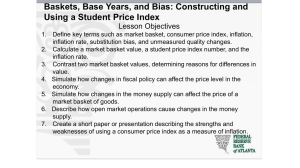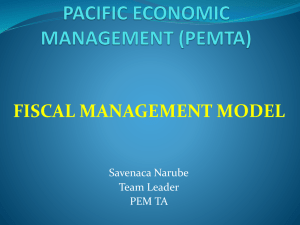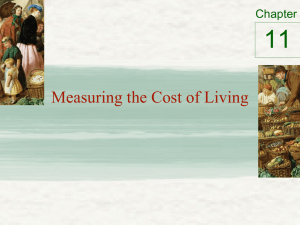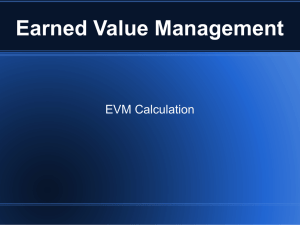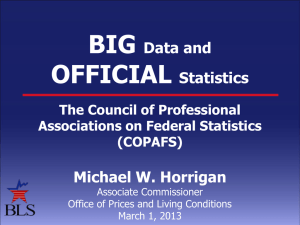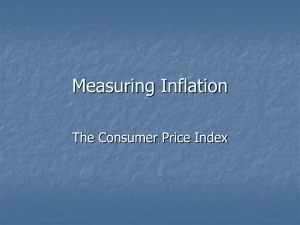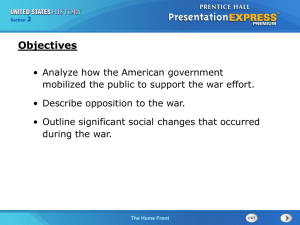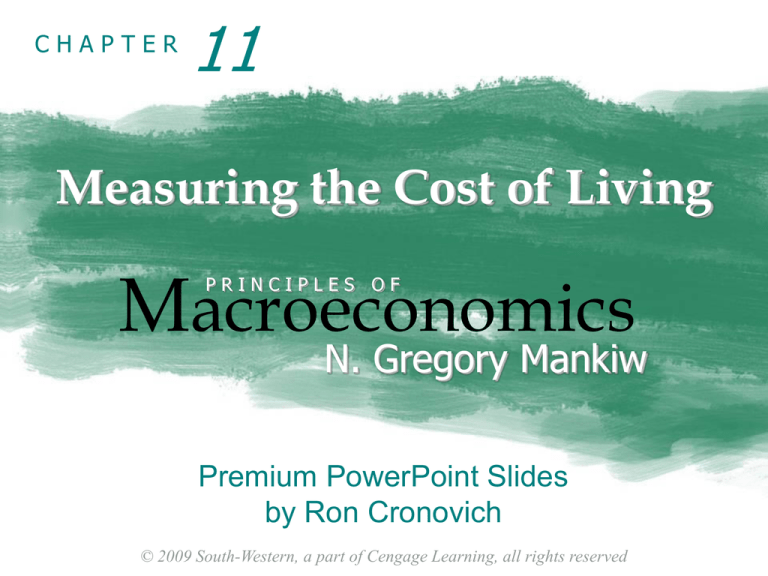
CHAPTER
11
Measuring the Cost of Living
Macroeconomics
PRINCIPLES OF
N. Gregory Mankiw
Premium PowerPoint Slides
by Ron Cronovich
© 2009 South-Western, a part of Cengage Learning, all rights reserved
In this chapter,
look for the answers to these questions:
What is the Consumer Price Index (CPI)?
How is it calculated? What’s it used for?
What are the problems with the CPI? How serious
are they?
How does the CPI differ from the GDP deflator?
How can we use the CPI to compare dollar
amounts from different years? Why would we want
to do this, anyway?
How can we correct interest rates for inflation?
1
The Consumer Price Index (CPI)
measures the typical consumer’s cost of living
the basis of cost of living adjustments (COLAs) in
many contracts and in Social Security
MEASURING THE COST OF LIVING
2
How the CPI Is Calculated
1. Fix the “basket.”
The Bureau of Labor Statistics (BLS) surveys
consumers to determine what’s in the typical
consumer’s “shopping basket.”
2. Find the prices.
The BLS collects data on the prices of all the
goods in the basket.
3. Compute the basket’s cost.
Use the prices to compute the total cost of the
basket.
MEASURING THE COST OF LIVING
3
How the CPI Is Calculated
4. Choose a base year and compute the index.
The CPI in any year equals
100 x
cost of basket in current year
cost of basket in base year
5. Compute the inflation rate.
The percentage change in the CPI from the
preceding period.
Inflation
=
rate
CPI this year – CPI last year
CPI last year
MEASURING THE COST OF LIVING
x 100%
4
EXAMPLE
basket: {4 pizzas, 10 lattes}
year
price of
pizza
price of
latte
2007
$10
$2.00
$10 x 4 + $2 x 10
2008
$11
$2.50
$11 x 4 + $2.5 x 10 = $69
2009
$12
$3.00
$12 x 4 + $3 x 10
cost of basket
= $60
= $78
Compute CPI in each year usingInflation
2007 base
rate:year:
2007: 100 x ($60/$60) = 100
2008: 100 x ($69/$60) = 115
2009: 100 x ($78/$60) = 130
MEASURING THE COST OF LIVING
115 – 100
x 100%
15% =
100
130 – 115
x 100%
13% =
115
5
ACTIVE LEARNING
Calculate the CPI
1
price price of
of beef chicken
CPI basket:
{10 lbs beef,
20 lbs chicken}
2004
$4
$4
The CPI basket cost $120
in 2004, the base year.
2005
$5
$5
2006
$9
$6
A. Compute the CPI in 2005.
B. What was the CPI inflation rate from 2005-2006?
6
ACTIVE LEARNING
Answers
1
CPI basket:
{10 lbs beef,
20 lbs chicken}
The CPI basket cost $120
in 2004, the base year.
price price of
of beef chicken
2004
$4
$4
2005
$5
$5
2006
$9
$6
A. Compute the CPI in 2005:
Cost of CPI basket in 2005
= ($5 x 10) + ($5 x 20) = $150
CPI in 2005 = 100 x ($150/$120) = 125
7
ACTIVE LEARNING
Answers
1
CPI basket:
{10 lbs beef,
20 lbs chicken}
The CPI basket cost $120
in 2004, the base year.
price price of
of beef chicken
2004
$4
$4
2005
$5
$5
2006
$9
$6
B. What was the inflation rate from 2005-2006?
Cost of CPI basket in 2006
= ($9 x 10) + ($6 x 20) = $210
CPI in 2006 = 100 x ($210/$120) = 175
CPI inflation rate = (175 – 125)/125 = 40%
8
What’s in the CPI’s Basket?
4% 3%
Housing
6%
Transportation
6%
Food & Beverages
43%
6%
Medical care
Recreation
Education and
communication
Apparel
15%
17%
MEASURING THE COST OF LIVING
Other
9
ACTIVE LEARNING
Substitution bias
CPI basket:
{10# beef,
20# chicken}
2004-5:
Households
bought CPI basket.
2
cost of CPI
beef chicken
basket
2004
$4
$4
$120
2005
$5
$5
$150
2006
$9
$6
$210
2006: Households bought {5 lbs beef, 25 lbs chicken}.
A. Compute cost of the 2006 household basket.
B. Compute % increase in cost of household basket
over 2005-6, compare to CPI inflation rate.
10
ACTIVE LEARNING
Answers
CPI basket:
{10# beef,
20# chicken}
Household
basket in 2006:
{5# beef,
25# chicken}
2
cost of CPI
beef chicken
basket
2004
$4
$4
$120
2005
$5
$5
$150
2006
$9
$6
$210
A. Compute cost of the 2006 household basket.
($9 x 5) + ($6 x 25) = $195
11
ACTIVE LEARNING
Answers
CPI basket:
{10# beef,
20# chicken}
Household
basket in 2006:
{5# beef,
25# chicken}
2
cost of CPI
beef chicken
basket
2004
$4
$4
$120
2005
$5
$5
$150
2006
$9
$6
$210
B. Compute % increase in cost of household basket
over 2005-6, compare to CPI inflation rate.
Rate of increase: ($195 – $150)/$150 = 30%
CPI inflation rate from previous problem = 40%
12
Problems with the CPI:
Substitution Bias
Over time, some prices rise faster than others.
Consumers substitute toward goods that become
relatively cheaper.
The CPI misses this substitution because it uses
a fixed basket of goods.
Thus, the CPI overstates increases in the cost of
living.
MEASURING THE COST OF LIVING
13
Problems with the CPI:
Introduction of New Goods
The introduction of new goods increases variety,
allows consumers to find products that more
closely meet their needs.
In effect, dollars become more valuable.
The CPI misses this effect because it uses a
fixed basket of goods.
Thus, the CPI overstates increases in the cost of
living.
MEASURING THE COST OF LIVING
14
Problems with the CPI:
Unmeasured Quality Change
Improvements in the quality of goods in the
basket increase the value of each dollar.
The BLS tries to account for quality changes
but probably misses some, as quality is hard to
measure.
Thus, the CPI overstates increases in the cost of
living.
MEASURING THE COST OF LIVING
15
Problems with the CPI
Each of these problems causes the CPI to
overstate cost of living increases.
The BLS has made technical adjustments,
but the CPI probably still overstates inflation
by about 0.5 percent per year.
This is important because Social Security
payments and many contracts have COLAs tied
to the CPI.
MEASURING THE COST OF LIVING
16
Two Measures of Inflation, 1950-2007
Percent
15
per Year
10
5
0
-5
1950 1955 1960 1965 1970 1975 1980 1985 1990 1995 2000 2005
CPI
MEASURING THE COST OF LIVING
GDP deflator
17
Contrasting the CPI and GDP Deflator
Imported consumer goods:
included in CPI
excluded from GDP deflator
Capital goods:
excluded from CPI
included in GDP deflator
(if produced domestically)
The basket:
CPI uses fixed basket
GDP deflator uses basket of
currently produced goods & services
This matters if different prices are
changing by different amounts.
MEASURING THE COST OF LIVING
18
ACTIVE LEARNING
3
CPI vs. GDP deflator
In each scenario, determine the effects on the
CPI and the GDP deflator.
A. Starbucks raises the price of Frappuccinos.
B. Caterpillar raises the price of the industrial
tractors it manufactures at its Illinois factory.
C. Armani raises the price of the Italian jeans it
sells in the U.S.
19
ACTIVE LEARNING
3
Answers
A. Starbucks raises the price of Frappuccinos.
The CPI and GDP deflator both rise.
B. Caterpillar raises the price of the industrial
tractors it manufactures at its Illinois factory.
The GDP deflator rises, the CPI does not.
C. Armani raises the price of the Italian jeans it
sells in the U.S.
The CPI rises, the GDP deflator does not.
20
Correcting Variables for Inflation:
Comparing Dollar Figures from Different Times
Inflation makes it harder to compare dollar
amounts from different times.
Example: the minimum wage
$1.15 in Dec 1964
$5.85 in Dec 2007
Did min wage have more purchasing power in
Dec 1964 or Dec 2007?
To compare, use CPI to convert 1964 figure into
“today’s dollars”…
MEASURING THE COST OF LIVING
21
Correcting Variables for Inflation:
Comparing Dollar Figures from Different Times
Amount
in today’s =
dollars
Amount
in year T
dollars
x
Price level today
Price level in year T
In our example,
year T = 12/1964, “today” = 12/2007
Min wage = $1.15 in year T
CPI = 31.3 in year T, CPI = 211.7 today
The minimum wage
in 1964 was $7.78
in today’s (2007) dollars.
MEASURING THE COST OF LIVING
$7.78 = $1.15 x
211.7
31.3
22
Correcting Variables for Inflation:
Comparing Dollar Figures from Different Times
Researchers, business analysts and policymakers
often use this technique to convert a time series of
current-dollar (nominal) figures into constant-dollar
(real) figures.
They can then see how a variable has changed
over time after correcting for inflation.
Example: the minimum wage, from Jan 1950 to
Dec 2007…
MEASURING THE COST OF LIVING
23
The U.S. Minimum Wage in Current Dollars
and Today’s Dollars, 1950-2007
$9
$ per hour
$8
2007 dollars
$7
$6
$5
$4
$3
$2
current dollars
$1
$0
1950 1955 1960 1965 1970 1975 1980 1985 1990 1995 2000 2005
ACTIVE LEARNING
4
Converting to “today’s dollars”
Annual tuition and fees, average of all public fouryear colleges & universities in the U.S.
1986-87: $1,414 (1986 CPI = 109.6)
2006-07: $5,834 (2006 CPI = 203.8)
After adjusting for inflation, did students pay more for
college in 1986 or in 2006? Convert the 1986 figure
to 2006 dollars and compare.
25
ACTIVE LEARNING
4
Answers
Annual tuition and fees, average of all public fouryear colleges & universities in the U.S.
1986-87: $1,414 (1986 CPI = 109.6)
2006-07: $5,834 (2006 CPI = 203.8)
Solution
Convert 1986 figure into “today’s dollars”
$1,414 x (203.8/109.6) = $2,629
Even after correcting for inflation, tuition and fees
were much lower in 1986 than in 2006!
26
Correcting Variables for Inflation:
Indexation
A dollar amount is indexed for inflation
if it is automatically corrected for inflation
by law or in a contract.
For example, the increase in the CPI automatically
determines
the COLA in many multi-year labor contracts
the adjustments in Social Security payments
and federal income tax brackets
MEASURING THE COST OF LIVING
27
Correcting Variables for Inflation:
Real vs. Nominal Interest Rates
The nominal interest rate:
the interest rate not corrected for inflation
the rate of growth in the dollar value of a
deposit or debt
The real interest rate:
corrected for inflation
the rate of growth in the purchasing power of a
deposit or debt
Real interest rate
= (nominal interest rate) – (inflation rate)
MEASURING THE COST OF LIVING
28
Correcting Variables for Inflation:
Real vs. Nominal Interest Rates
Example:
Deposit $1,000 for one year.
Nominal interest rate is 9%.
During that year, inflation is 3.5%.
Real interest rate
= Nominal interest rate – Inflation
= 9.0% – 3.5% = 5.5%
The purchasing power of the $1000 deposit
has grown 5.5%.
MEASURING THE COST OF LIVING
29
Real and Nominal Interest Rates in the U.S.,
1950-2007
Interest Rates
(percent per year)
15
10
5
0
-5
-10
1950 1955 1960 1965 1970 1975 1980 1985 1990 1995 2000 2005
Nominal interest rate
MEASURING THE COST OF LIVING
Real interest rate
30
CHAPTER SUMMARY
The Consumer Price Index is a measure of the
cost of living. The CPI tracks the cost of the typical
consumer’s “basket” of goods & services.
The CPI is used to make Cost of Living
Adjustments and to correct economic variables for
the effects of inflation.
The real interest rate is corrected for inflation
and is computed by subtracting the inflation rate
from the nominal interest rate.
31

